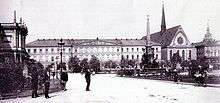
Augusteum
An Augusteum (plural Augustea) was originally a site of imperial cult in ancient Roman religion, named after the imperial title of Augustus. It was known as a Sebasteion in the Greek East of the Roman Empire. Examples have been excavated in Sebaste/Samaria, Constantinople, Aphrodisias, Antioch, Cartagena, and (most famously) Ankara.
Since the 18th century, the term has also been used for certain academic and cultural buildings, such as the Augustea in Leipzig, Oldenburg, and Wittenberg.
See also
References

Augusteum, Oldenburg
The Augusteum is an art museum in the city of Oldenburg, Lower Saxony, Germany. The museum houses the old master painting collection of the State Museum for Art and Cultural History.
The museum opened in 1876 as Oldenburg's first art museum. The building is in the neo-Renaissance style. The Augusteum presents old master artworks including examples by Christian Griepenkerl and Johann Heinrich Wilhelm Tischbein. The Augusteum building is near the northeast corner of the Schlossgarten Oldenburg. The Prinzenpalais, Elisabeth-Anna-Palais, and Schloss Oldenburg are all close to the museum.
See also
References
External links
Coordinates: 53°08′10″N 8°13′00″E / 53.1362°N 8.2166°E / 53.1362; 8.2166

Augusteum (Leipzig)
The Augusteum was a building on the Augustusplatz in Leipzig, Germany, to the left of the Paulinerkirche. It was the original site of the University of Leipzig.
History
The Augusteum was built between 1831 and 1836 to plans by Albert Geutebrück, though its façade referred back to a classicist design by Karl Friedrich Schinkel. The building had, however, already reached its full capacity by the 1870s since the university had grown due to major urban expansion in this period. The building was generously rebuilt and expanded from 1892 to 1897 by the architect Arwed Rossbach. The Augusteum had originally only had a front onto the Augustusplatz, but (due to the demolition of the Paulinum) could now receive a south wing known as the Johanneum (1895), a middle wing known as the Albertinum (1896) and a west wing known as the Paulinum (1896). The renovation also altered the building's style to fit in better with other buildings on the Augustusplatz, with Neo-Renaissance and Neo Gothic façades being added to the Paulinerkirche and Augusteum to plans by Rossbach.
Podcasts:

